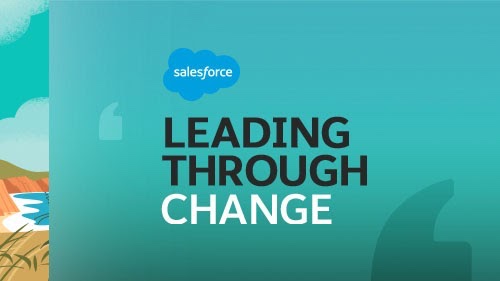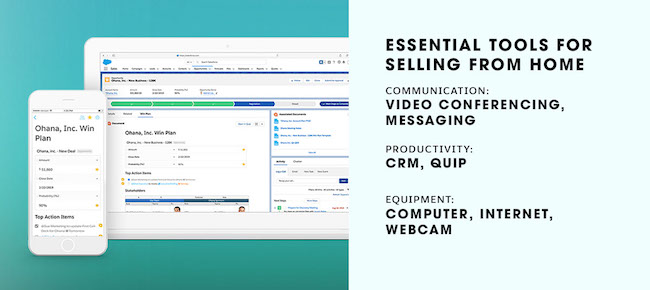COVID-19 has changed the way we do sales forever. Nearly everyone is now a virtual, remote seller, and that will remain mostly true even when it’s safe for us to go back to the office. It’s a major shift – one that’s led many of you to reach out for advice on how to best sell from home. Well, ask and you shall receive.
I’ve talked to tens of thousands in the sales industry about growth and innovation over the years, written a book about it, and today I host a podcast about it. It’s my passion. And I hope I can continue to share it with you during this difficult time.
Below are my answers to the top 10 most common questions I’ve been getting from salespeople and sales managers around the world over the past few weeks. I’ll also share examples of how real Salesforce customers and sales leaders are inspiring me during this time.
1. I’m worried I won’t hit my quota. Are people still buying?
Yes, of course people are still buying, but here’s my caveat: what and how they’re buying depends on what industry you’re in. What are you selling? To whom and for what purpose? Some products are flying off the shelves, while others are nice to haves.
If you’re selling something that helps people solve for their immediate problems of survival or growth, then yes, people are buying. For example, 3M is producing 100 million respirators per month to aid in this crisis, doubling their global output to a rate of more than 1.1 billion per year. Others, however, are facing challenges, including many in the travel and hospitality industry.
At the end of the day, the world is still turning, and deals are still closing. It’s just that most, if not all, buyers are homebound. The litmus test is whether what you’re selling will put your customer in a stronger personal or professional position right now.
2. How do I keep deals moving when I can’t see, speak to, or easily connect with prospects?
I’ve had many conversations over the years with salespeople and sales executives that believe they can only sell face-to-face. They tell me their business or industry requires a relationship that can only happen in person. I’m not a fan of that point of view. Those sellers seem more interested in holding onto the way they have always sold, not thinking about what their customers want in today’s hyper-connected digital world. For those sellers, this is a really tough situation to navigate.
For those who are more comfortable with social selling — engaging virtually using video or social media platforms — and marketing and sales automation, the current reality is a bit easier to maneuver.
In both cases, it’s a salesperson’s job to make sure they add value for customers at each touch point. Keeping deals moving might be as simple as letting your customers know you’re there if they need you. Or it might mean presenting via video chat to a virtual room full of decision makers, who now work from home, and don’t have access to everything they might need to make a decision.
Maybe you can get creative and set up daily video consulting engagements to offer customers advice. Case in point: founder & CEO of PepTalkHer Meggie Palmer has curated a series of daily #PowerPepTalks that encourages people to find their superpowers and skill-up during extra downtime. All registrants are funneled into Salesforce Essentials to track and nurture leads with customised content and follow up.
Every seller is in uncharted waters when it comes to bringing in new leads and communicating with customers. So here’s my best piece of advice: let customers set the pace. Let customers set a sense of urgency (or not). Don’t push your own agenda of retiring quota. If you do, when things get back to normal, you’ll have a worse problem on your hands: a (self-inflicted) lost opportunity.
3. Without in-person meetings, how do I create a genuine connection with my customers?
Breathe in. Breathe out. There’s no need to panic. Just because you can’t see someone in person does not mean you can’t build a relationship with them. Who you are will shine through whether it’s face-to-face or over the phone. If you’ve always looked out for your customer, you will be just fine. Play the long game. Don’t get blinded by short-termism.
Yes, you have an existing pipeline. Yes, you have a quota to retire. Yes, your sales forecasts shift every day. Those things are true, but they’re not what your customers are thinking about. They’re thinking about how to keep their businesses open, manage their newly remote workforce, and scale their operations quickly.
PayPal has seen this firsthand in their recent customer service calls, with merchants asking for assistance on expanding cash flow and access to funds. As a result, the company waived certain fees and deferred some payments. Their actions are a master class on how by focusing on solving your customer’s problems, you too can create long-term connections. Read more about how this Trailblazer is leading through change.
If you haven’t talked to your customers in a while, it might not be the right time to do so. That may sound harsh, but any attempt to build the relationship now will likely come off as inauthentic and opportunistic unless you really nail the EQ aspect. Only you know what the reality is, and this isn’t the time to misrepresent or have over-confidence in your relationship.
4. How should I adjust tone and messaging for my customers? What’s the right conversation to have with them?
It all comes down to emotional intelligence, or EQ. Think carefully about the words and playbooks you use when selling and whether they’re still appropriate for this time. If in doubt, ask a friend for a gut check. Err on the side of caution.
I recently received an email from a company asking me if I wanted to buy life insurance. Yes, life insurance. As thousands of people around the world are getting sick or dying, they wanted to talk about my post-life options. Talk about tone deaf. Now, it’s not that I’m not interested, but am I interested right now in an email that read like it was business as usual? Not really.
If you are selling something that may not be appropriate during this time, hold off on the overt push. Instead, focus your message on your customers’ wellbeing. Are they okay? Is there anything you can do to help? What are their needs?
Or consider holding off on communicating in general. People are being bombarded with “we’re here for you” messages from companies they haven’t heard from in years. Consider if your message is coming out of the blue or simply isn’t helpful. If either is true, nix it.
And don’t forget to turn off your automated follow-up emails or marketing and sales campaigns that were set up prior to this pandemic. People will remember how you behaved during this time, and you don’t want to be the company that forgot to cancel their April Fool’s Day prank this year.
5. Should I focus on acquiring new pipeline or just focus on closing existing pipeline?
You’re a salesperson for a reason. You love to sell! So I wouldn’t recommend picking one over the other. However, similar to my response to question #2, you have to truly listen to what your customers and prospects are telling (or not telling) you in this environment. Follow their lead. If they respond and appear interested in continuing to discuss the deal, then that’s where you should focus your attention.
What I don’t recommend is mass emailing every contact in your database without any personalisation, value, or insight. Instead, rally around your customers. Go back to your existing customers and sell more of what you’ve already sold to them. Come up with creative ways to connect. Recently, Amazon Web Services Educate began offering free webinars and office hours to help their customers build skills in remote education while schools are physically shut down. Existing customers have already proven they’re willing to do business with you. This is the time to nurture that relationship.
If that isn’t possible and you have to go hunting for new business, then you’ll have to work harder to rise above the noise. Infuse your messaging with the proper level of both empathy and value-based selling to avoid looking like you’re capitalising on a crisis.
6. I’m a field salesperson. My job is literally to drive around and sell. What do I do now?
Imagine the car salesperson. Their entire livelihood is dependent on people showing up at the dealership, taking customers on test drives, and closing the deal, usually face-to-face. With social distancing, that can’t happen right now. So what’s a field rep to do now that they’re stuck inside? Well, embrace inside sales.
As a field rep, you know the product extremely well. That makes you a valuable asset for the nurturing and distribution of leads. In the example of a car salesperson, maybe instead of meeting with customers, you can manage the phones at the call center or respond to incoming email leads. Or maybe you can reach out to your previous customers to learn about opportunities that might be available once your business gets back to normal. Checking in on a past sale might lead you to your next.
And if you’re a sales leader, don’t forget to distribute knowledge among inside sellers and field sellers. One of our manufacturing customers is having their inside sales team train their field reps. When knowledge flows freely in your organisation, everyone wins. Watch our webinar to learn about how 3M retrained their sales team from home.
7. What adjustments should I make for sales enablement and sales operations?
As your field reps now have to work from home as well, and basically become inside sellers, give them what they need. Do they lack video conferencing tools? Do they need different kinds of emails and door openers? Other kinds of content? Ask your sellers what would set them up for success during this time, and go forth.
If you find yourself not completely swamped by the task above, this might be the opportunity to inventory the processes you have in place and streamline it for everyone involved.
Sales reps spend only one-third of their time selling, according to Salesforce Research. What are the inefficiencies your sales enablement and sales operations can fix to boost that number? When we round the corner on the coronavirus (and we will), those who took the time to work on this will be in a far better position to ramp up.
8. What tools are companies using to sell from home?
Video is going to play a much larger role in everything sellers do going forward. And I’m not just talking about highly produced videos. I’m talking about the video chats with interruptions from your kids, your cat, and the gardener; live webinars with casual delivery; and the bad bandwidth pixelating it all. The future of work is going to be a lot more reliant on talking to someone through a screen and a little more forgiving of those working from home.
At Salesforce, we use a variety of video tools to collaborate, including Google Hangouts. (My colleague Sarah Franklin wrote about some other non-video collaboration tools.) I’m also on LinkedIn Live, where I use video as a way to keep up with my followers and share my insights.
And honestly, a good CRM is your best friend in times like this. (I know, I know. I’m biased.) Knowing who your customers are, reviewing dashboards on recent wins and losses, tracking leads by source – all the sales data in your CRM is now more important than ever.
9. How do I use video to sell? What are your tips for overcoming the challenges of the virtual pitch?
Personalise it. A lot of people have been reaching out to ask how I’m doing. The message that stood out the most? A short selfie video that said, “Hey Tiffani, I was thinking about you. Hope everything is good,” along with a few other things. This person could have emailed me that same message, but seeing their face made it much more encouraging.
Video is truly bridging the gap between people during this crisis. For example, SightCall is a two-way video conferencing solution for Salesforce that helps healthcare providers and patients mitigate non-essential contact. I think this pandemic might be the catalyst that fast-tracks how sales reps use video as an everyday way to communicate. We’ve already seen virtual happy hours and even Passover meals become part of our lives.
If you’re not comfortable with video, it’s time to get comfortable. I’m a firm believer of pushing your limits and trying new things. For starters, you can try sending a video message to the people you’re closest with. They’ll likely be a lot more forgiving of the awkward pauses. Once you’re more comfortable, all of my usual tips for making a good sales pitch still apply.
10. What sales skills should I brush up on while I’m at home?
Improve on what you’re not as good at. Is it lead qualification? Is it social selling? Is it writing? If you’re having trouble, talk to your manager to brainstorm ideas. There are a ton of resources out there for whatever you might be looking for.
Some places to start: Coursera, Lynda, and Udemy. Salesforce also offers this free Trailhead trail filled with concrete tips on how to build your sales career.
I get asked a lot for advice on how to become a sales thought leader. Here’s the first step: start giving advice. Then see if it actually helps people! I know I’m always checking to see if mine did.
Got more questions?
Ask me on social media. I’m answering your questions on LinkedIn, Twitter, and Facebook.
For more business and leadership inspiration, check out our entire Leading Through Change series.








